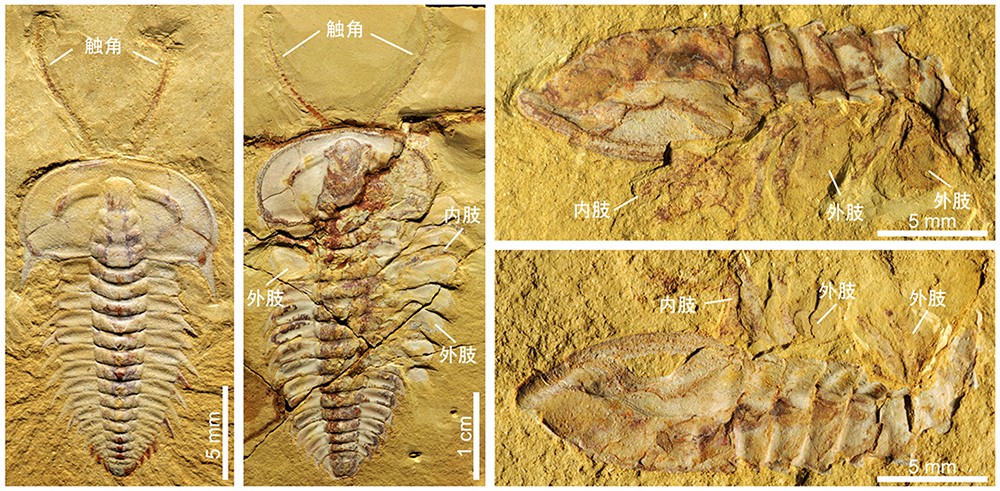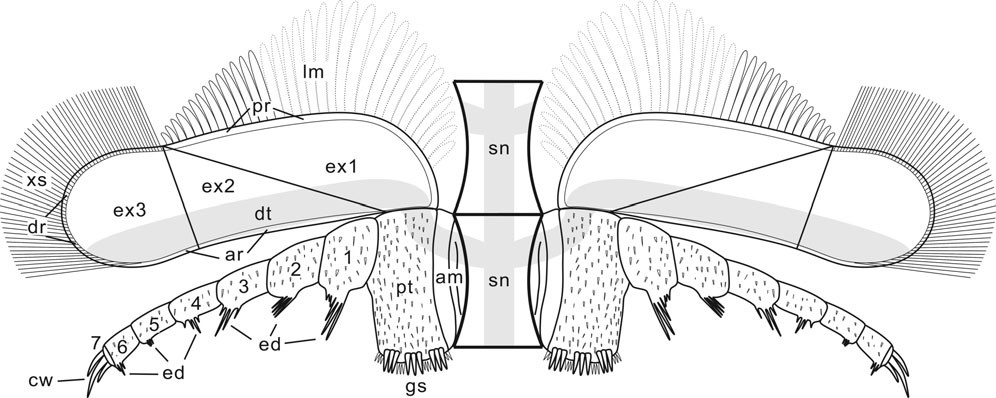Recently, ZENG Han (PhD student) and his colleagues from the Nanjing Institute of Geology and Palaeontology, Chinese Academy of Sciences described in detail the appendages of an early Cambrian trilobite Hongshiyanaspis yiliangensis Zhang & Lin in Zhang et al., 1980 (Redlichiida, Metadoxididae) from the Cambrian Xiazhuang fossil assemblage at the suburban of Kunming, Yunnan. This is the seventh trilobite species with complete appendages described and reconstructed in the world, and the second one in China after Eoredlichia intermedia from the Chengjiang Lagerstätte. The new data supports the mandibulate affinities of trilobites.
Trilobites are one of the most diverse extinct groups of arthropods that inhabited Paleozoic seas from the Cambrian explosion to the end-Permian mass extinction (~ 520–250 Ma). So far, more than 20,000 trilobite species have been discovered. However, nearly 99% trilobite species are named based on morphology of exoskeletons, the soft bodies of trilobites are poorly known. In particular, complete walking limbs of trilobites have only been reconstructed in six species from exceptionally preserved fossil deposits. This limited knowledge of the trilobite soft anatomy, especially appendages, has long constrained our understanding on the evolutionary position of trilobites on the arthropod tree of life.
Owing to increasing numbers of exceptionally well-preserved arthropods from the Cambrian Chengjiang (Yunnan, China) and the Burgess Shale (British Columbia, Canada) during the last two decades, the artiopods (meaning bearing a complete set of similar appendages), a miscellaneous group of Cambrian arthropods possessing similar body plans and appendage structures with trilobites, are widely accepted as the closest relatives of trilobites. However, no consensus has been reached on the closest extant arthropod group of trilobites and artiopods, as either Chelicerata or Mandibulata.
The appendages of H. yiliangensis exhibit the common architecture revealed by other trilobites and artiopods by consisting of a pair of uniramous antennae followed by a series of paired homonomous biramous limbs. The antennae in holaspid individuals comprise up to 27 spinous podomeres and their ontogeny occurs by lengthening of the podomeres. The post-antennal biramous limbs are similar to those in other trilobites and artiopods by having a single-segmented protopodite and an endopodite comprising seven segments, but possess a unique wide tripartite exopodite with long setae.
Appendages of trilobites, artiopods and other upper stem-group euarthropods are compared and summarized. The H. yiliangensis appendages highlight the high morphological disparity of exopodites and the conservativeness of endopodites in trilobites and artiopods. This morphological pattern, together with similar body patterning seen in crustaceans but not in chelicerates, supports the mandibulate affinities of trilobites and at least some artiopods.
This research was funded by the National Natural Science Foundation of China, the Ministry of Science and Technology of China, and the Chinese Academy of Sciences.
Article information: Han Zeng, Fangchen Zhao*, Zongjun Yin, Maoyan Zhu. 2017.Appendages of an early Cambrian metadoxidid trilobite from Yunnan, SW China support mandibulate affinities of trilobites and artiopods.Geological Magazine: 1–23. doi: 10.1017/S0016756817000279. (*corresponding author)

Early Cambrian trilobite Hongshiyanaspis yiliangensis preserved with complete appendages (Image by Zeng et al.)

Reconstruction of limbs of early Cambrian trilobite Hongshiyanaspis yiliangensis (Image by Zeng et al.)
(Information Source: Nanjing Institute of Geology and Paleontology,CAS)

